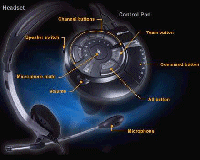|
Microsoft Sidewinder Game Voice |
|
Product Review by Quinton Evans |
Personally, I love Microsoft hardware. Their equipment is cheap, strong and reliable. I should know. I've smashed, bashed, fiddled with, stress-tested and generally put through the paces almost every major Microsoft gaming device on the market, and they've all come up trumps.
"Personally, I love Microsoft hardware. Their equipment is cheap, strong and reliable."
I now have the gleeful duty of reporting on one of the newest and most advanced voice command control centers from the guys at Microsoft R&D, the Sidewinder Game Voice. Packaged with a spiffy headset and Game Voice module, the Game Voice does two things: it acts as a chat program, and functions as a game control system. Using profiles to bond commands from any game to your voice is as simple as titling the command, keying in the appropriate keyboard command from the game, and clicking save. There isn't any need to train the Game Voice as it uses phonetics and only requires a small test to check if the microphone picks up your voice correctly. Functionality is equally simple. Instead of fooling around with your keyboard, basic voice commands like "shotgun" or "build town hall" let you manipulate inventory or perform tasks in a matter of seconds, while keeping your hands free for more important things. The Game Voice is also a complete team communication system allowing hands-free communication with other teammates or even opponents. And they don't even need another Game Voice to talk. Everything they need to chat back to you is packaged into a bundle of software called Game Voice Share, available for downloading at gamevoice.com. Six light-touch buttons on the topside of the unit operate the multiplayer voice chatting feature. The keys you press are processed through software which runs in the background of your game. Players must connect to your system via an assigned IP address, which is accomplished by adding each person to a buddy list using the MSN Messenger service (an easy task that even this reviewer could manage without difficulty). Once connected, players can be assigned to one of four private channels with the touch of a button. If you play with a team on say, Counter Strike, multiple individuals can be placed on the team channel, which can be addressed by pressing the team button on the control unit. All players can be contacted using the All button. And if you have a particularly annoying team, there is also a mute button.
"Once connected, players can be assigned to one of four private channels with the touch of a button."
Nearly all games have key commands, and pretty much anything that is normally assigned to a keyboard can be programmed into the Game Voice. Actions such as changing weapons in Elite Force or issuing order to marines in Ground Control can be achieved purely by speaking the assigned command word or phrase. The choice of commands and phrases is entirely up to you. For instance, in Half-Life if you want to switch to the grappling hook you could assign anything your imagination desires. If that phrase happens to be "butt muncher", then your weapon will change to the grappling hook when you say the magic words. You have complete freedom to choose whatever you wish. Microsoft has included an impressive number of games with their own preset profiles (fully adjustable), but the list of compatible games is virtually limitless since users can create their own profiles with remarkable ease. Game Voice gets around potential language problems by using phonetics; instead of entering words as they're spelled, you enter them the way they sound. The speech-recognition technology (developed by Lernout & Hauspie) then matches spoken words to the letter sounds stored in memory. The Game Voice is amazingly accurate at recognizing commands, and there is absolutely no need to train the device at all. But if you need to fine tune a command, the system also includes a playback feature that reads a selected word back to you. If it sounds like the word you want, good. If it sounds like your best mate after several pints of Guinness, then you should think about changing the command.
"If it sounds like your best mate after several pints of Guinness, then you should think about changing the command."
While aimed at multiplayer gaming, the Game Voice can also be used offline to trigger commands in a single player game, like issuing orders to wingmen in a flight sim or selecting weapons in a shooter. Just use your imagination; the possibilities are almost endless. Microsoft has made the whole experience simple and above all, fun, which is perfect for less technically-minded gamers like me. Gamers of all types can benefit from the Game Voice, online and off. But online gamers will find it absolutely invaluable, especially when playing games like Counter-Strike, where team tactics are essential. Imagine yelling, "I've found the hostages!" or "Jay, I need a sniper on the ground floor, look for window movement!" instead of madly pecking away at your keyboard. Once you've tried it, you'll never want to go back.
Essential Data Minimum Requirements Reviewed on
|

![[Next]](../buttonNextI.jpg)

